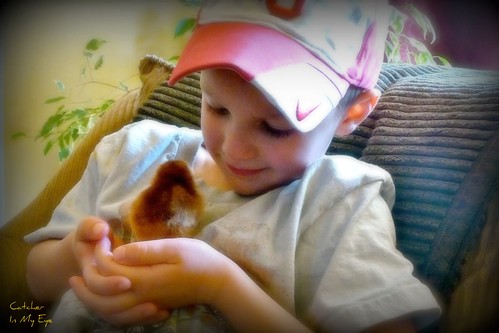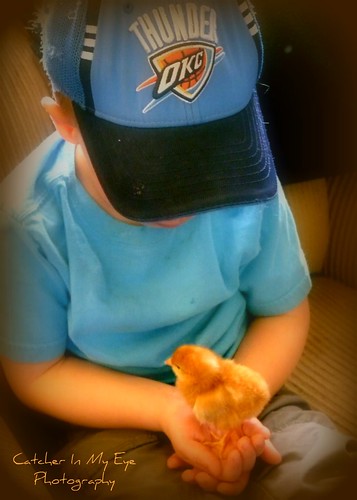A Peep at Teenage CHICKS, a set on Flickr.
ONE MONTH OLD CHICKS are considered TWEEN chicks in chicken world...At Four weeks, my chicks hit the GAWKY stage and the inquisitive age!
They were more fun than a barrel of moneys to watch and play with :)
As they learned to spread their little wings and fly, they learned how to roost on the stock tank edges...and when chicks roost, they *poop*!
Chicks escaping in our home was the catalyst that got my hubby and I to start building the Chicken coop...FAST!
Some CHICK CARE tips to follow:
Some CHICK CARE tips to follow:
CHICK CARE AFTER FOUR WEEKS:
| 1. | Increase floor area to 3/4 square feet per bird. | |
| 2. | Increase feeders to provide 2-1/2" to 3" of space per bird. | |
| 3. | Increase waters to one 5-gallon fount per 100 birds. | |
| 4. | Make sure grit hopper is filled with proper sized grit. Check with your feed man. | |
| 5. | Install roosts at back of brooder area. Allow four inches per bird with roost poles six inches apart. | |
| 6. | Open windows in day-time. Leave only partly open at night. | |
| 7. | Prevent water puddles around founts. Place founts on platforms. | |
| 8. | Birds can range outside on warm, sunny days, but only if clean range is available. |



































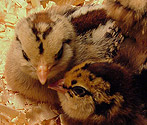 So, now you have cute baby chicks...
So, now you have cute baby chicks...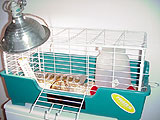 The chicks' first home is called a "brooder". For one-time or once-in-a-while use, a cardboard box works just fine. A cage suitable for a rabbit or guinea pig is terrific and easy to clean (see picture). Some people even use an aquarium! The bottom should have a layer of clean litter (pine shavings or similar) or newspaper.
The chicks' first home is called a "brooder". For one-time or once-in-a-while use, a cardboard box works just fine. A cage suitable for a rabbit or guinea pig is terrific and easy to clean (see picture). Some people even use an aquarium! The bottom should have a layer of clean litter (pine shavings or similar) or newspaper.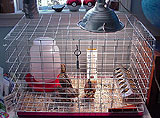 The size of the brooder depends on how many chicks you have - the chicks should have enough room to move around, and to lay down and sleep. You also need to have enough space in it for a waterer and a feeder (see below).
The size of the brooder depends on how many chicks you have - the chicks should have enough room to move around, and to lay down and sleep. You also need to have enough space in it for a waterer and a feeder (see below).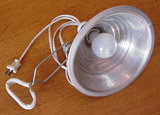 The brooder can be heated by using a light bulb with a reflector, available at any hardware store. A 100-watt bulb is usually fine, though some people use an actual heat lamp. The temperature should be 90-100 degrees for the first week or so, then can be reduced by 5 degrees each week thereafter, until the chicks have their feathers (5-8 weeks old). A thermometer in the brooder is helpful, but you can tell if the temperature is right by how the chicks behave. If they are panting and/or huddling in corners farthest from the light, they are too hot. If they huddle together in a ball under the light, they are too cold. You can adjust the distance of the light (or change the wattage of the bulb) until it's right.
The brooder can be heated by using a light bulb with a reflector, available at any hardware store. A 100-watt bulb is usually fine, though some people use an actual heat lamp. The temperature should be 90-100 degrees for the first week or so, then can be reduced by 5 degrees each week thereafter, until the chicks have their feathers (5-8 weeks old). A thermometer in the brooder is helpful, but you can tell if the temperature is right by how the chicks behave. If they are panting and/or huddling in corners farthest from the light, they are too hot. If they huddle together in a ball under the light, they are too cold. You can adjust the distance of the light (or change the wattage of the bulb) until it's right.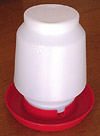 Clean, fresh water must ALWAYS be available to your chicks. Get at least a medium size waterer - chicks drink a LOT of water. We like this plastic kind, it's easy to clean, inexpensive, lightweight and they can't tip it over. They also poop everywhere including right into their water; clean the waterer at least once a day (depending on how crowded it is, even twice a day).
Clean, fresh water must ALWAYS be available to your chicks. Get at least a medium size waterer - chicks drink a LOT of water. We like this plastic kind, it's easy to clean, inexpensive, lightweight and they can't tip it over. They also poop everywhere including right into their water; clean the waterer at least once a day (depending on how crowded it is, even twice a day).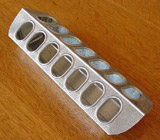 Even baby chicks will naturally scratch at their food, so a feeder that (more or less) keeps the food in one place is good. The feeder shown is a popular design made of galvanized steel; the top slides off to clean and fill it. Again, cleanliness is important; the chicks will poop right into their own food, so you must clean and refill it often.
Even baby chicks will naturally scratch at their food, so a feeder that (more or less) keeps the food in one place is good. The feeder shown is a popular design made of galvanized steel; the top slides off to clean and fill it. Again, cleanliness is important; the chicks will poop right into their own food, so you must clean and refill it often.
